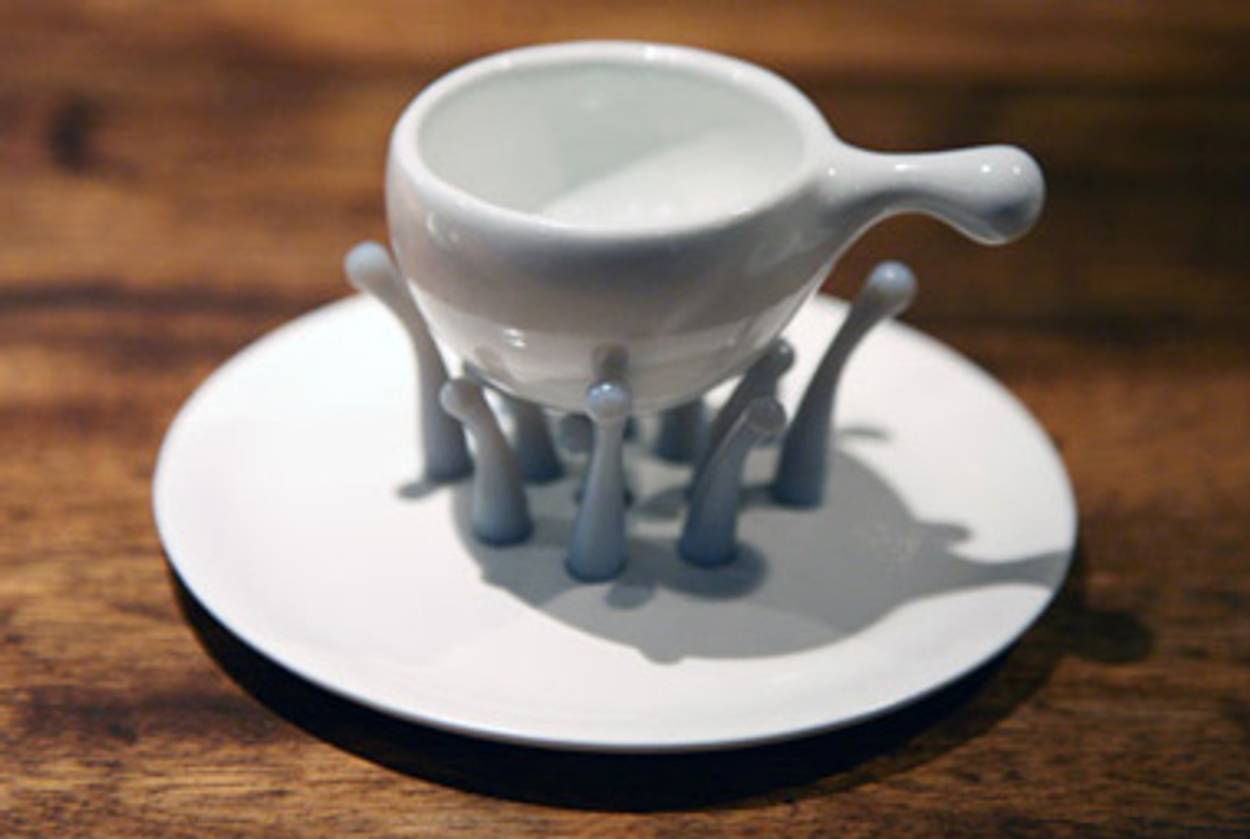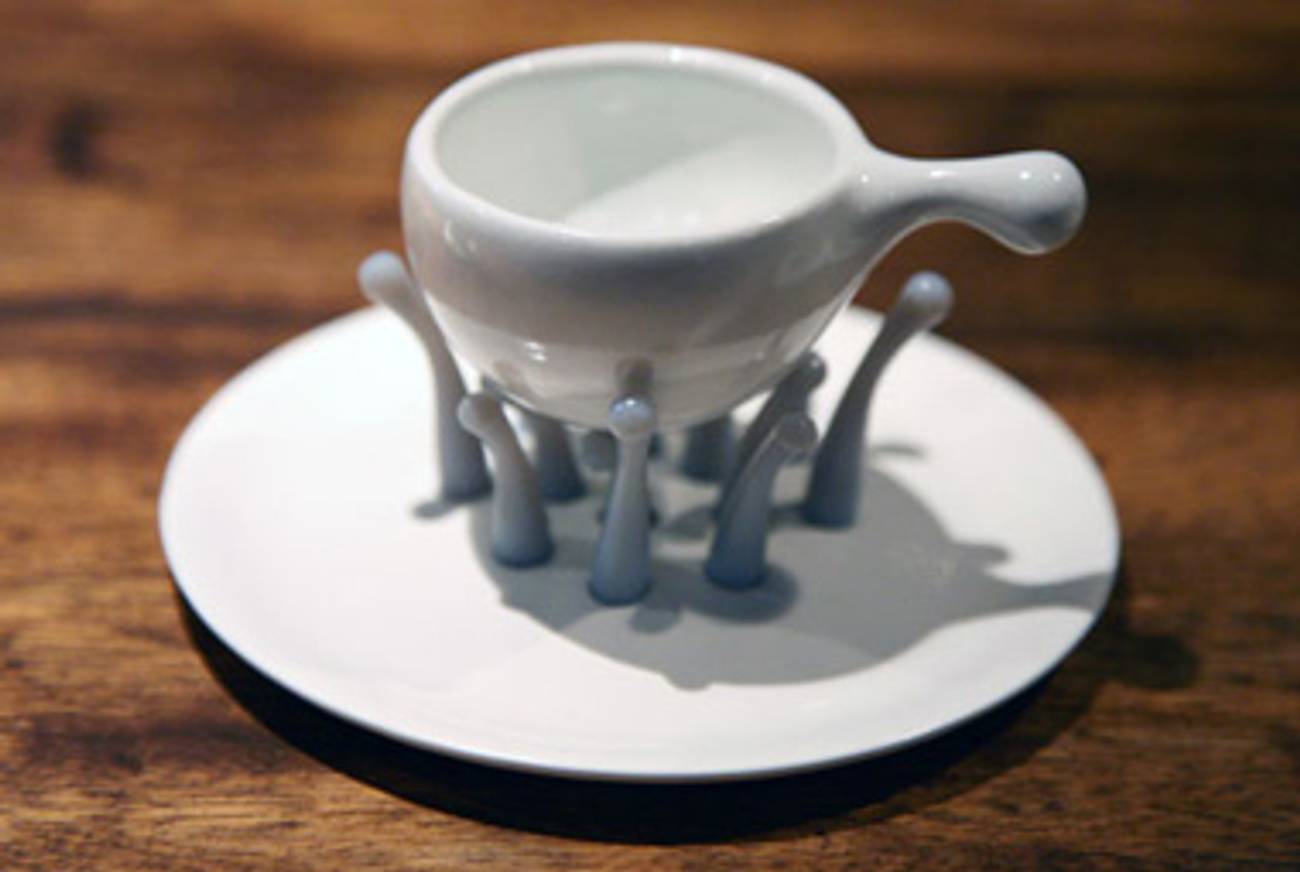The Boiling Point
What Israel’s coffee culture says about the country’s future




Israeli society, alas, is a mosaic made of small conflicts. There’s the unease between eastern Jews and western Jews, for example, or the tension between ancient tradition and modern culture. All of these conflicts, however, manifest themselves in one mundane thing—the very thing so many of us miss terribly as we observe the Tisha B’av fast today—a simple cup of coffee.
As anyone who has so much as visited Israel in the last six decades knows, the Jewish state is highly caffeinated. Whether they are taking a business meeting in a Tel Aviv café or bonding with brothers-in-arms on a desert dune, Israelis are never without their restorative, sipping the stuff early and often.
But how best to drink it? Herein lies the bitter fight tearing Israeli society apart.
On the one hand are the finjan folk, believers in the beaked, long-handled pot traditionally used to brew coffee by the peoples of the region and also known, with slight variations, as a cezva, a raqwa or an ibrik. No matter what you call it, the principle remains the same: scoop coffee and sugar into the pot, pour water, bring to a boil. Which is where the finjan folk get weird. For coffee to live up to its true essence, any of them will tell you, it must be boiled no fewer than seven times; anything less, and you might as well drink day-old decaf. There is, of course, no evidence to support this theory.
Like most other occurrences of the number seven in Jewish folklore, the myth of the seven boils based more in custom than science. But while this lengthy method of brewing may have little do with coffee, it has everything to do with companionship, assuring that for many long moments, the anticipating drinkers would huddle around the campfire and exchange pleasantries as they watch their drink bubbling to perfection.
Could there be a better beverage for soldiers, guarding remote outposts on long, brisk nights? From the nation’s very birth, the finjan became as much a symbol of the renewing Jewish nation in its ancestral homeland as the Galil assault rifle, the Merkava tank, or the Davidka, the famed homemade mortar that was credited with so many of the Israeli army’s gains during the country’s War of Independence. So popular was the finjan, that Chaim Chefer, the poet laureate of the Palmach, the precursor to the Israel Defense Forces, wrote a poem about the small pot: “The wind blows coolly,” it goes, “the fire flickers, the song is blooming.” Moshe Wilenski, the era’s most famous Israeli composer, put Chefer’s words to music. The refrain is meant to be belted out loud: “the finjan spins around and around and around, the finjan spins around and around.” Every Israeli child knows this song by heart. When Israelis think of the sepia-toned heroism of their nation’s struggle for independence, the country’s finest hour, they think of a primitive coffee-making device.
The Israeli army has changed much since the days of the Palmach, replacing its antiquated rifles with hi-tech weapons, but the finjan is still strong with men in uniform. Every self-respecting fellow reporting for reserve duty—most Israeli men continue to serve between one and three months for at least three decades after their mandatory service ends at age 21—is likely to have, somewhere in the recesses of his dufflebag, a tin full of coffee, some sugar, and a battered finjan.
It wouldn’t have been the first time that coffee was conscripted: legend has it that after the Battle of Vienna in 1683, the armies of the Holy League discovered sacks full of mysterious green beans left behind by the defeated Turks. These, in turn, were awarded to the King of Poland, who gave them to the heroic officer Jerzy Franciszek Kulczycki. As savvy in business as he was on the battlefield, Kulczycki soon realized that his strange beans made for a magical brew, set up shop, and changed Viennese culture forever.
The story, compelling as it is may be, is apocryphal. Vienna’s first coffee shop was opened by a Greek merchant who had nothing to do with the King of Poland or the vanquished Ottoman Empire. But those Israelis looking for suitably caffeinated forefathers could raise a steaming cup to the man known to us today only as Jacob the Jew, an entrepreneur who, in 1650, inaugurated The Grand Café in Oxford, the first institution of its kind in England.
Within a century or so, the lion’s share of financial, intellectual, and social life in the world’s largest empire was discussed in coffeehouses, where—as the Abbé Prévost, the renowned French novelist, famously put it—one had “the right to read all the papers for and against the government,” making coffeehouses no less than the “seats of English liberty.” It didn’t take long for London to sort out its drinking infrastructure: There were separate coffeehouses for nautical insurance agents and coffeehouses for professional wits, tables reserved for Whigs and other tables, a safe distance away, only for Tories.
Which brings us back to that other group of Israelis. Whereas the finjan folk swear by their finely ground Turkish coffee, often laced with cardamom and cooked meticulously over a fire, their nemeses, the espresso people, vow that a cup isn’t perfect unless it was pulled from a chrome-plated Gaggia machine into a pre-heated cup. They often scoff at the very mention of Turkish coffee, still commonly referred to by Israelis of both persuasions as botz, or mud, an eloquent description of the soggy grounds collected in the bottom of the cup.
These men and women see themselves as Jacob the Jew’s true heirs. Not only do they consider their method of preparation far superior to the finjan’s primitive capabilities—after all, what are seven boils compared to more than seventeen bars of pressure pushing water onto tightly packed coffee grounds?—but they are also quick to take pride in their coffeehouse culture at large, a culture of trendy cafés serving dark and viscous espresso shots to a well-groomed clientele that gulps at its leisure, munching on flaky pastries as it finalizes big business deals. It is a very different culture than the army’s. It is, like England’s coffee houses of old, a culture of commerce and contest, not camaraderie.
Occasionally— could it be any different?—these two worlds collide. Even the staunchest sipper of espresso may find himself holding the finjan’s long handle and counting to seven, and even the most fastidious finjanist may find herself craving a double skim macchiato from time to time. (There is also a third group, consisting of people who drink instant coffee—which, regardless of brand, is referred to in Israel as Nescafé—but with this being a day of atonement and all, we shall spare them the opprobrium they so richly deserve). But the very existence of these two coffee camps betrays more than a mere divergence in personal preferences. It speaks of a schism between the Israel of then and the Israel of now, the nation of fighters sharing a cup and a song and the nation of software engineers negotiating their start-ups, the boundless promise of the land and the strict confines of the city.
Like every other struggle, this one, too, has its apparent victors. As a recent exhibit at Shenkar, Israel’s premiere school of design, demonstrates all too well, when young Israelis think of coffee nowadays they look to the porcelain and ceramic of France and Italy, not the banged-up tin cups soldiers used to carry around. They look more to Alessi than to the Palmach. One student even created an espresso cup resembling a miniature, stout finjan, resting on ceramic stalks reminiscent of flames. The finjan ethos, wild and glorious, was reduced, in this elegant design, to a brilliant and white demitasse. The designs in the exhibition, beautiful as they may be, tell a subtle and sad story: gone are the days when Israelis would huddle together, the wind blowing coolly, the fire flickering, the song blooming, and the finjan spinning around and around and around.
Liel Leibovitz is a senior writer for Tablet Magazine and a host of the Unorthodox podcast.
Liel Leibovitz is editor-at-large for Tablet Magazine and a host of its weekly culture podcast Unorthodox and daily Talmud podcast Take One. He is the editor of Zionism: The Tablet Guide.